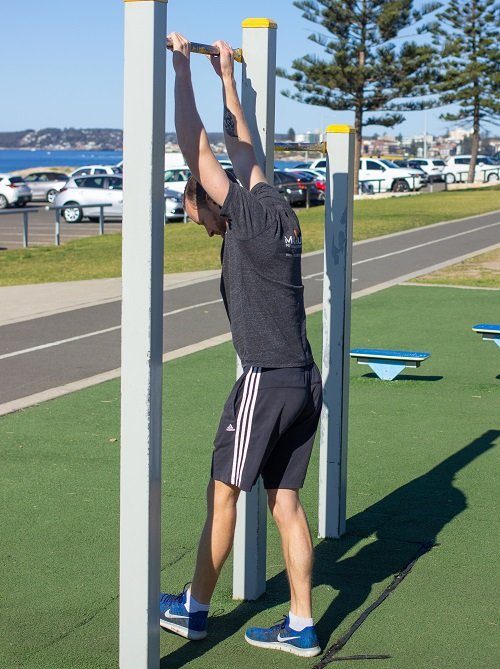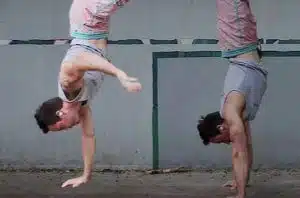We’ve all been there! Your strength is progressing nicely for weeks, even months, then suddenly you don’t seem to be making any progress for weeks at a time.
This is referred to as a plateau.
Have You Really Hit a Plateau?

Sometimes with calisthenics you may think you’ve hit a plateau as your numbers aren’t improving.
However, your form may be improving without you being aware of it and in this case you don’t need to make changes just yet.
This is really common with pull-ups where sometimes I see a student kicking less, pulling higher or going lower, but they’re not hitting higher numbers, so they think they’ve plateaued.
After pointing out the improvement in form, they realise they haven’t plateaued and the numbers eventually start going up again.
However, sometimes you really do hit a plateau and in this case, you may have to make some adjustments to your training to bust through that plateau.
Here are 12 techniques and lifestyle changes you can use to get past your plateau.
1. Switch Progressions
With bodyweight training, there are many paths of progression to the same exercise.
You only have to do a YouTube search for Planche / One Arm Pull-up progression or any other high-level exercise and each video will likely show you different progressions.
This is why at Maximum Potential Calisthenics, our calisthenics fundamentals skill tree has multiple paths to the same exercise.
If you plateau on one path, you can simply switch to another.
Start making progress on this path for a few months and you will see big improvements in your original progression path.
2. Use Isometrics
Isometric exercises, that is holding one point of an exercise for time, is a specific technique we use at MP Calisthenics to bust through plateaus in that range of motion.
For example, if you’re struggling to get height on a pull-up, try holding yourself over the bar for time.
Make sure you also include the full range of motion as part of your training, probably on another day.
Do this for a few weeks and you will soon find your pull-up height improving.
3. Use Eccentrics
The eccentric phase, often referred to as a negative, is the down phase of a bodyweight movement.
Studies have shown that you can gain up to 10% more strength focussing on the eccentric phase of an exercise.
To use this for plateau busting, simply do the negative phase of the next progression in your plan.
For example, if you’re stuck trying to get your pull-ups up to 10, you can try climbing to the top of the bar, then doing an eccentric L pull-up, slow and controlled.
Rep these out and you’ll find your pull-ups improve.
4. Train More Often
Sometimes with a plateau, you have to take an honest look at your training and ask yourself if you’re training often enough.
At MP Calisthenics, we recommend you train a minimum of 3 sessions a week to see good strength improvements.
Alternatively, it may be that you aren’t being consistent enough; one week you may be doing 3 sessions, another only 1.
In this case, look at what you can do to improve your consistency or add in another training session to your workout.
5. Train Less Often
The other side of that is you may be training too often.
Your body needs rest time to recover. Strength training every day, for example, is not something we recommend.
This is more likely to build endurance than it is max strength.
If you feel overtrained, try giving yourself a day to recover, maybe do some cardio or some stretching.
6. Grease the Groove
Grease the Groove is an excellent way to improve the max reps you can do a specific exercise.
Essentially it involves performing an exercise throughout the day to avoid fatigue.
Check out this article on Grease the Groove for more information.
7. Adjust Your Rep Range
This is a simple way to break through a rep plateau.
The strength and hypertrophy rep guidelines have you at 3-6 reps and 8-12 reps respectively, so you can always move within these numbers.
For example, say you’re struggling to hit 5 sets of 5 reps for an exercise, try 6 sets of 4 reps instead.
Once this is manageable, you can either progress to the next exercise if you’re happy with this rep range or then try 5 x 5 again.
8. Use Cluster Sets
Cluster setting is a technique I’ve been using as long as I can remember, only recently did I discover it had a name.
This involves doing as many as you can toward your goal for the set, take a few seconds rest, then finish off the set.
For example, if you’re trying to do 10 pull-ups, but can only manage 8, then get down from the bar, shake your arms off a little, then get back up after 10 seconds or so and do another.
If you manage 2 then move on, otherwise, repeat until you’ve done 10 total.
9. Cluster Set with Eccentrics
This is another one of my favourite ways of busting through plateaus.
We’ve already discussed that eccentrics work well and introduced cluster sets.
So why not combine them together.
First, max out your exercise (assuming you can’t yet reach your set target).
Then finish it off with negatives.
For example, if you can only do 3 pull-ups and you’re trying to reach 5, then finish with 2 slow and controlled eccentrics.
10. Improve Your Nutrition
It’s no secret that poor nutrition will slow down your calisthenics training.
For one thing, if your nutrition is poor then you quite possibly need to lose a little bodyfat too.
The more bodyfat you store, the harder calisthenics is.
However, even if you have a low bodyfat percentage, poor nutrition can still wreck your training.
Too much sugar, alcohol, or when you eat in relation to your training can all have a detrimental effect.
Try cleaning up your nutrition, eat more real food and less processed food and see if you notice a difference.
11. Get More Sleep
Sleep is when our body recovers from training excursions.
It’s when our testosterone recharges and muscles grow. It’s when our nervous system recovers.
If you’re not getting enough sleep, this can severely restrict your ability to exercise.
Aim for 8 hours of sleep a day.
If you’re some way off that, then built it up or consider adding a siesta to your daytime schedule if possible.
12. Be Patient
I’ve put this last because it’s probably not the answer that you want to read if you’re looking to break a plateau.
However, sometimes it just takes a bit of time of consistent training to finally get through that plateau.
After this, you may find you start progressing again.



